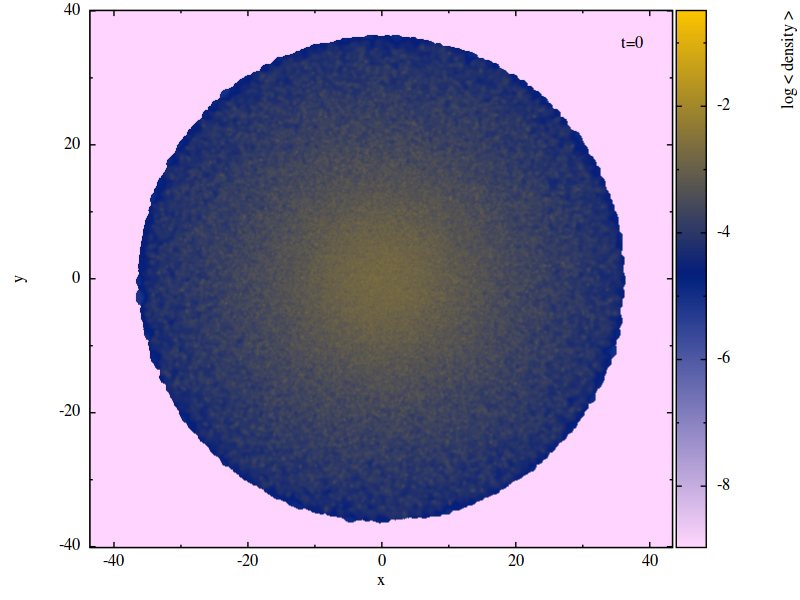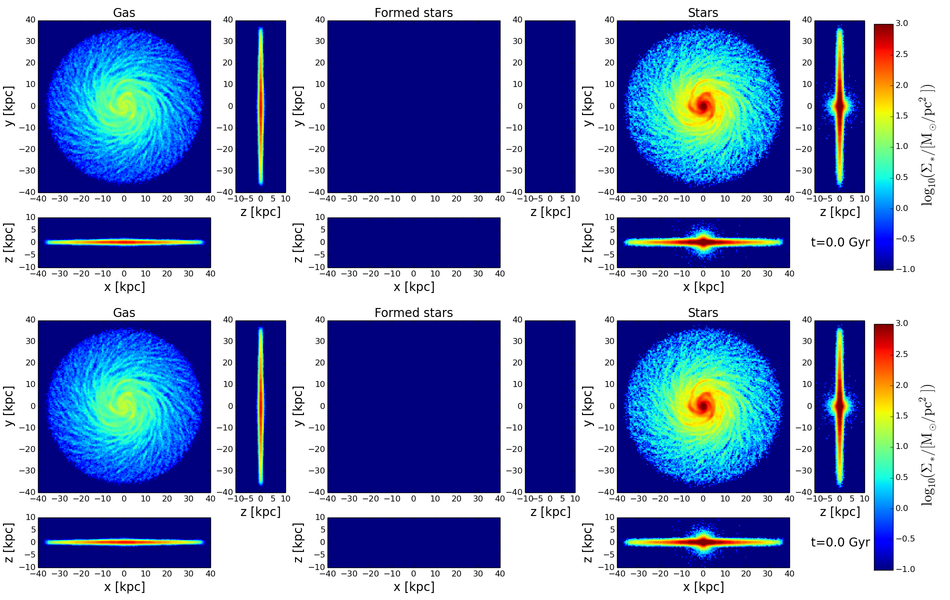Publications
My publications on the SAO/NASA Astrophysics Data System (ADS).
Radial migration in galactic discs
Stars in galactic discs do not have purely circular orbits. They oscillate radially about an average galactocentric radius (epicyclic excursions) and can also change of average radius when they gain or lose angular momentum because of resonances such as bars or spiral arms. I have quantified radial migration of stars in a disc simulation in this paper, highlighting how the slowing-down of a bar can mix stars in a significant part of a disc, with however outskirts of the disc that can remain unaffected. The trapping of stars at corotation of a bar (in a disc with thick components) was then studied in more detail in this paper,
Vlasov-Poisson
I have worked on different ways of numerically solving the Vlasov-Poisson equations that describes the evolution of a collisionless self-gravitating fluid. Dark matter or stars in galaxies are modelled as such a fluid satisfying this system of equations, but as the system is difficult to solve numerically, simplifications such as the N-body method are often used. It is interesting to see the advantages or drawbacks of these methods compared with particle-less codes. Dark matter or stars in galaxies are modelled as such a fluid satisfying this system of equations, but as the system is difficult to solve numerically, simplifications such as the N-body method are often used. It is interesting to see the advantages or drawbacks of these methods compared with particle-less codes. In this paper, looking at phase-space with a high-resolution, we were able to distinguish different phases of dynamical evolution of self-gravitating spherical systems more or less dynamically cold, and to investigate different instabilities.
Growth of cosmological structures
Using cosmological 1D simulations (one dimension in position and one in velocity), I have also studied the formation of large-scale structures, more precisely how different scales are coupled to each other and how (AND WHY) the conclusions drawn from these simulations, fully non-linear, differ from the predictions of perturbation theory, in this paper.
Ph.D thesis
My Ph.D. thesis can be downloaded here. I worked on the impact of baryonic physics on simulations of galaxies. The Lambda-CDM paradigm encounters problems at the galactic scale: density cusps in the centre of halos, or too numerous satellites. Including some precise and reliable baryonic physics is an issue: limited space and mass resolution make "sub-grid" recipes necessary. During my PhD, I added to the publicly available MPI code Gadget-2 some stochastic star formation and core collapse supernovae feedback, and detailed cooling including cooling by metals and molecular hydrogen at low temperatures, so as to study the cold phase of the interstellar medium. Taking molecular hydrogen into account allows for some slow star formation to occur in the outer metal-poor parts of disc galaxies. I used my simulations to study the impact of molecular hydrogen cooling in this paper, and to study radial migration of stars due to epicyclic excursions or to resonances (bar and spiral arms) in this other paper.
You can see below a video done with SPLASH. It is the density of the gas component of a spiral galaxy that forms a bar and spiral features. The simulation includes cooling and kinetic feedback.
 Next is a film of the different components of some of the galactic discs I simulate. The simulated tim-span is of 8 Gyr (time is visible on the bottom right corner of each row). Top row is a silulation including molecular hydrogen cooling. Bottom row is a simulation with the same parameters but with no molecular hydrogen. It can be seen that the stellar disc of formed stars (second column) is more extended when molecular hydrogen cooling is taken into account (especially visible in the edge-on views).
Next is a film of the different components of some of the galactic discs I simulate. The simulated tim-span is of 8 Gyr (time is visible on the bottom right corner of each row). Top row is a silulation including molecular hydrogen cooling. Bottom row is a simulation with the same parameters but with no molecular hydrogen. It can be seen that the stellar disc of formed stars (second column) is more extended when molecular hydrogen cooling is taken into account (especially visible in the edge-on views).

MOND
I did a six-months project about MOdified Newtonian Dynamics with HongSheng Zhao in the University of St Andrews, Scotland. MOND was initiated by Milgrom in the 1980s as an attempt to account for some galactic and galaxy clusters properties without resorting to dark matter. A relativistic counterpart that could be reduced to MOND in the non-relativistic limit - as General relativity reduces to Newtonian gravity - has been worked on and relates to researches about Lorentz-invariance breaking theories. My project was about theories involving a Lorentz-invariance breaking four-vector field, often called the "Aether" field. You can read about it in the paper I published with HongSheng and Baojiu Li.